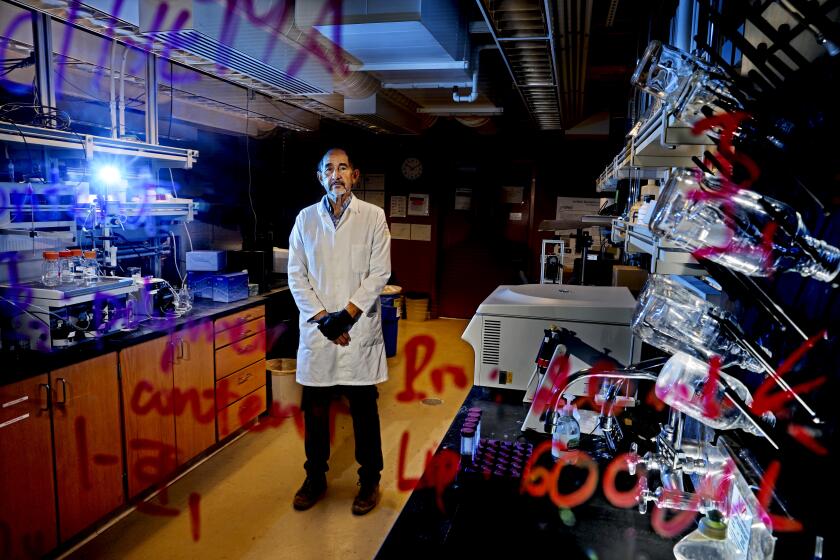When can we eat cultured meat? It’s an ingredient issue
- Share via
This story is part of our series on the future of cultured and plant-based meat. Read more here.
For the record:
3:21 p.m. Oct. 21, 2021A previous version of this article states that Eat Just cultured chicken nuggets were a mix of pea protein and cultured meat and that the product was first sold in Singapore in March 2021. The ingredients included mung bean protein and cultured meat, and the nuggets were first sold in Singapore in December 2020.
Production of cultured meat, created in a stainless steel tank, is happening in labs around the world. But producing it at a volume and cost where it fulfills the promise of replacing conventional meat is a hurdle that no startup has shown it can clear — yet.
One of the biggest challenges? Ingredients.
You might assume that alternative proteins do not involve animal products, that their labels can include two very important words, “slaughter-free.” But when it comes to cultured meat, it’s complicated.
The easiest way to cultivate meat or fish is to take a few cells from a live animal and toss them into a bioreactor filled with a nutrient-rich broth — which is spiked with fetal bovine serum, or FBS, an expensive cell-growth stimulant harvested from unborn calves. (FBS typically is collected during the slaughter of pregnant cows.)
According to Maarten Bosch, CEO of the Dutch cultured meat company Mosa Meat, “everyone” started out using FBS. Once they got off the ground, however, cultured meat companies started to invest tens of millions of dollars and years of effort into developing replacements.
Bosch says Mosa Meat has solutions to the FBS dilemma, a common claim across the industry. But no company in the fiercely competitive — and secretive — industry is sharing the details.
Companies are flocking to alt-protein central — California
One San Francisco-based company has hustled an FBS-assisted product into restaurants — in Singapore. Eat Just, originally a plant-based alt-protein company founded in 2011, jumped into cultured meat early on. And founder Josh Tetrick has been running hard ever since to stay ahead of the pack of 80-plus cultured meat producers around the world.
When Tetrick started selling Eat Just cultured chicken nuggets (the ingredients included mung bean protein and cultured meat) in Singapore in December 2020, it was the first time a government anywhere had approved cultured meat for sale.
“We continue to use FBS, though as little as possible,” says Tetrick, who adds that the company now has a replacement growth stimulant (and that’s all he’ll say) and is trying to get a new FBS-free chicken approved for sale in Singapore. “Consumers definitely want to eat meat without feeling bad about it. Some care more than others.”
Others in the industry are critical of the sale of any cultured meat created with FBS. “We are taking our time to do this right,” says Bosch. “No GMOs, no slaughter, meat that does not harm the earth,” he says. “In Singapore, you have a company that just wanted to be first.”
Berkeley’s Alt: Meat Lab connects students interested in creating plant-based proteins with potential investors
“Scaffolding” has been another stumbling block for an industry that wants to produce protein without any animal products whatsoever.
Meat cells will naturally differentiate into muscle, fat and other animal tissues given the right bioreactor conditions, cultured meat companies say, but the cells need to adhere to something. In 2019, Harvard University scientists made a huge splash when they unveiled a product — with the texture of real chicken — that used gelatin for its scaffolding. The muscle cells naturally clung to it because gelatin comes from animal bones and skin, says Christophe Chantre, CEO of Boston Meats, a Somerville-based cultured meat startup founded by some of those Harvard scientists.
After the unveiling, Boston Meats started to work on finding a plant-based substitute for scaffolding, Chantre says, and now it has a solution — which it will not discuss.
Wildtype, a San Francisco-based company, is anticipating commercial sales of its cultured salmon — made without gelatin or FBS — as soon as next year. It is building a production plant in the Bay Area, and company officials say they will be ready to apply for U.S. regulatory approval to sell its salmon as soon as the USDA and FDA publish the protocols, which are expected in a few months.
“We did not want to tell people our cultured fish is made with pig hoofs,” says Wildtype co-founder Aryé Elfenbein.
Wildtype salmon looks remarkably like … salmon. White stripes of fat lace through the taut, light orange flesh just as they do in real fish. Firmer than farmed salmon and slightly firmer than wild, the taste is, well, a bit bland, which is to be expected. After all, it’s a slab of protein that never went for a swim.
Cultured meats and fish don’t have the full flavor of their conventional counterparts. In real life, animals have muscles that flex; their development is influenced by a gut biome. Of course, none of that happens in a lab. But cultured meats and fish do hint at the flavor of the animal donating the cells. As the proteins grow in those stainless steel tanks, they are fed the same carbohydrate- and nitrogen-rich diet as cows, chicken, pigs or fish would have eaten, albeit processed into a liquid. The better the feed, the better the meat’s nutritional profile, according to cultured meat companies.
Despite a collective $1.3 billion invested in cultured meat companies, it
will be years before you will encounter an array of cultured meat and fish at the grocery store, but stay tuned. They could be available in select San Francisco-area restaurants next year.
More to Read
Eat your way across L.A.
Get our weekly Tasting Notes newsletter for reviews, news and more.
You may occasionally receive promotional content from the Los Angeles Times.











